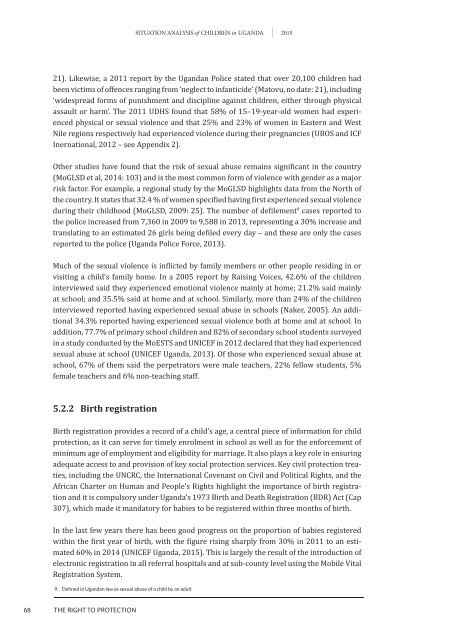Situation analySiS
1TNu802
1TNu802
You also want an ePaper? Increase the reach of your titles
YUMPU automatically turns print PDFs into web optimized ePapers that Google loves.
<strong>Situation</strong> <strong>analySiS</strong> of Children in uganda 201521). Likewise, a 2011 report by the Ugandan Police stated that over 20,100 children hadbeen victims of offences ranging from ‘neglect to infanticide’ (Matovu, no date: 21), including‘widespread forms of punishment and discipline against children, either through physicalassault or harm’. The 2011 UDHS found that 58% of 15–19-year-old women had experiencedphysical or sexual violence and that 25% and 23% of women in Eastern and WestNile regions respectively had experienced violence during their pregnancies (UBOS and ICFInernational, 2012 – see Appendix 2).other studies have found that the risk of sexual abuse remains significant in the country(MoGLSD et al, 2014: 103) and is the most common form of violence with gender as a majorrisk factor. For example, a regional study by the MoGLSD highlights data from the North ofthe country. It states that 32.4 % of women specified having first experienced sexual violenceduring their childhood (MoGLSD, 2009: 25). The number of defilement 9 cases reported tothe police increased from 7,360 in 2009 to 9,588 in 2013, representing a 30% increase andtranslating to an estimated 26 girls being defiled every day – and these are only the casesreported to the police (Uganda Police Force, 2013).Much of the sexual violence is inflicted by family members or other people residing in orvisiting a child’s family home. In a 2005 report by Raising Voices, 42.6% of the childreninterviewed said they experienced emotional violence mainly at home; 21.2% said mainlyat school; and 35.5% said at home and at school. Similarly, more than 24% of the childreninterviewed reported having experienced sexual abuse in schools (Naker, 2005). An additional34.3% reported having experienced sexual violence both at home and at school. Inaddition, 77.7% of primary school children and 82% of secondary school students surveyedin a study conducted by the MoESTS and UNICEF in 2012 declared that they had experiencedsexual abuse at school (UNICEF Uganda, 2013). Of those who experienced sexual abuse atschool, 67% of them said the perpetrators were male teachers, 22% fellow students, 5%female teachers and 6% non-teaching staff.5.2.2 Birth registrationBirth registration provides a record of a child’s age, a central piece of information for childprotection, as it can serve for timely enrolment in school as well as for the enforcement ofminimum age of employment and eligibility for marriage. It also plays a key role in ensuringadequate access to and provision of key social protection services. Key civil protection treaties,including the UNCRC, the International Covenant on Civil and Political Rights, and theAfrican Charter on Human and People’s Rights highlight the importance of birth registrationand it is compulsory under Uganda’s 1973 Birth and Death Registration (BDR) Act (Cap307), which made it mandatory for babies to be registered within three months of birth.In the last few years there has been good progress on the proportion of babies registeredwithin the first year of birth, with the figure rising sharply from 30% in 2011 to an estimated60% in 2014 (UNICEF Uganda, 2015). This is largely the result of the introduction ofelectronic registration in all referral hospitals and at sub-county level using the Mobile VitalRegistration System.9. Defined in Ugandan law as sexual abuse of a child by an adult68 thE rIGht to ProtECtIoN




